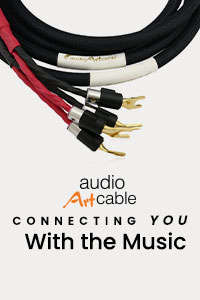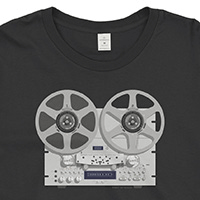Nakamichi ZX-7 Cassette Deck
 While some audiophiles complain about the high cost of components in the 21st Century, back in 1981 when Nakamichi introduced the ZX-7, it had a retail price of $1,250. That’s right, $1,250 for a cassette deck. The first generation of CD players had just hit the market and they sounded dreadful, and reel-to-reel tape recorders were headed out the door as well. Much like any technology, the cassette deck was discontinued just as it had reached the peak of its development.
While some audiophiles complain about the high cost of components in the 21st Century, back in 1981 when Nakamichi introduced the ZX-7, it had a retail price of $1,250. That’s right, $1,250 for a cassette deck. The first generation of CD players had just hit the market and they sounded dreadful, and reel-to-reel tape recorders were headed out the door as well. Much like any technology, the cassette deck was discontinued just as it had reached the peak of its development.
Featuring a discrete three-head design, you could monitor your recordings right from the tape just like an open-reel deck, and the ZX-7 also featured the industry standard Dolby B and the newer Dolby C noise reduction. While Dolby C offered an additional 6 dB higher level of noise reduction than Dolby B, it was more susceptible to problems with head alignment and caused serious “fluttering” in the playback if not perfectly aligned.
Adjustments galore
The ZX-7’s claim to fame was its multiple adjustments for standard type I tape, type II (chrome) and type IV (metal) tapes, allowing the user to adjust record azimuth, bias, EQ and record level/balance. The ability to fine tune these adjustments was a big part of what gave the flagship Nakamichi decks their ability to capture so much musical information on that tiny strip of tape, often putting lesser open-reel decks to shame, albeit at a much higher price. Right around this time, you could still purchase a TEAC 2300 for about $600, so this was pretty stratospheric pricing.
Once the deck was set for your tape of choice, you were ready to start recording! Along with all the adjustments, the deck had a full logic transport that was like butter. The tapes were handled with the utmost of care.
Fond memories
Using a ZX-7 back in the mid-1980s, I found it to be a great deck to save wear and tear on my record collection and indispensable at parties when everyone had had a drink or two. I’m sure the Nak paid for itself in phono cartridges not destroyed back then.
But the best part was the sound. This deck truly did have many of the attributes of an open-reel deck with a frequency response that extended out to 22kHz with metal tape, which retailed for about $50 for a case of 10 TDK 90-minute tapes. The uber-cool ones with metal and see-through acrylic housings were about $10 each! They didn’t sound that much better than the standard plastic ones, but they looked serious. Today, if you can find them in the shrink wrap, they can fetch $75-$125 each. Crazy.
I recently found a mint ZX-7 at my local HiFi shop, Echo Audio in Portland, Oregon, and I couldn’t resist doing the time warp again. I had a mint 600 series II in for a tune up at the time and the shop owner made it very easy for me to get out of the 600 and into the ZX-7. A quick market check reveals that these decks in perfect shape can run about $500. If you have a local tape-deck expert, expect to pay about $125-$175 to have the deck thoroughly cleaned and adjusted properly. Just like when buying a vintage sports car, buy the best deck you possibly can; you don’t want to start doing major repairs on one of these.
It’s pretty wacky inserting a vintage cassette deck into a six-figure reference system, but the ZX-7 still delivers the goods after all these years. And I still managed to have a couple of TDK MA-R’s in my private stash ready to go (because I rarely get rid of anything, especially if it’s a discontinued audio format).
Cuing up the Raven TWO, I put together a mix tape of some of my favorite MoFi records from the same time period and it was a great blast from the past. With the additional resolution of today’s HiFi gear, it’s easier to see where the Nakamichi’s limitations are. Even though the metal tape offers up great high-frequency extension, there is a modest loss in dynamics and image focus that gives the tape away.
But when heard through a more-vintage system, consisting of a Marantz 2275 receiver, Technics SL-1200/Shure V15 table and a pair of JBL L-100’s, even the chrome bias tapes that I made with the ZX-7 are indistinguishable from the vinyl playback. That’s what made the ZX-7 so highly coveted in its day.
If a full-blown reel-to-reel deck frightens you, think about a high-performance cassette deck. They are a ton of fun and for now, parts are plentiful. Should you go down the Nakamichi path, you can get more background information at www.naks.com
 Keeping the ship afloat – Phoenix Tape Company
Keeping the ship afloat – Phoenix Tape Company
Larry Mellette remains the ultimate tape-deck enthusiast. Along with his other website, tapeheads.net, he started manufacturing cassette tapes. “It started with a company I was working with; they had enough metal tape stock to make about 3,500 tapes, so I bought it all.” He also has a line of two different chrome tapes and the shells are loaded to order, so this is a labor of love, not the second coming of Maxell.
But that’s great news for those of us who haven’t turned our back on our cassette decks. While he won’t reveal his source for tape stock, Mellette said, “You’d be surprised if I told you who made the tape.” He’s sold 3,000 tapes so far, with a dealer in the UK (Tapeline), Australia (Gamve) and tapes.com here in the US.
Following in the footsteps of those who have been bringing reel-to-reel tape decks back to the forefront of audiophilia, Mellette is working on a cassette deck of his own. The design is not finalized yet, but he thinks the first deck will be playback only.
If you still love your cassette deck, join the forum at tapeheads.net. It’s a great group of enthusiasts with a large cache of information on tape decks of all formats, as well as a buying/trading area. -Jeff Dorgay






